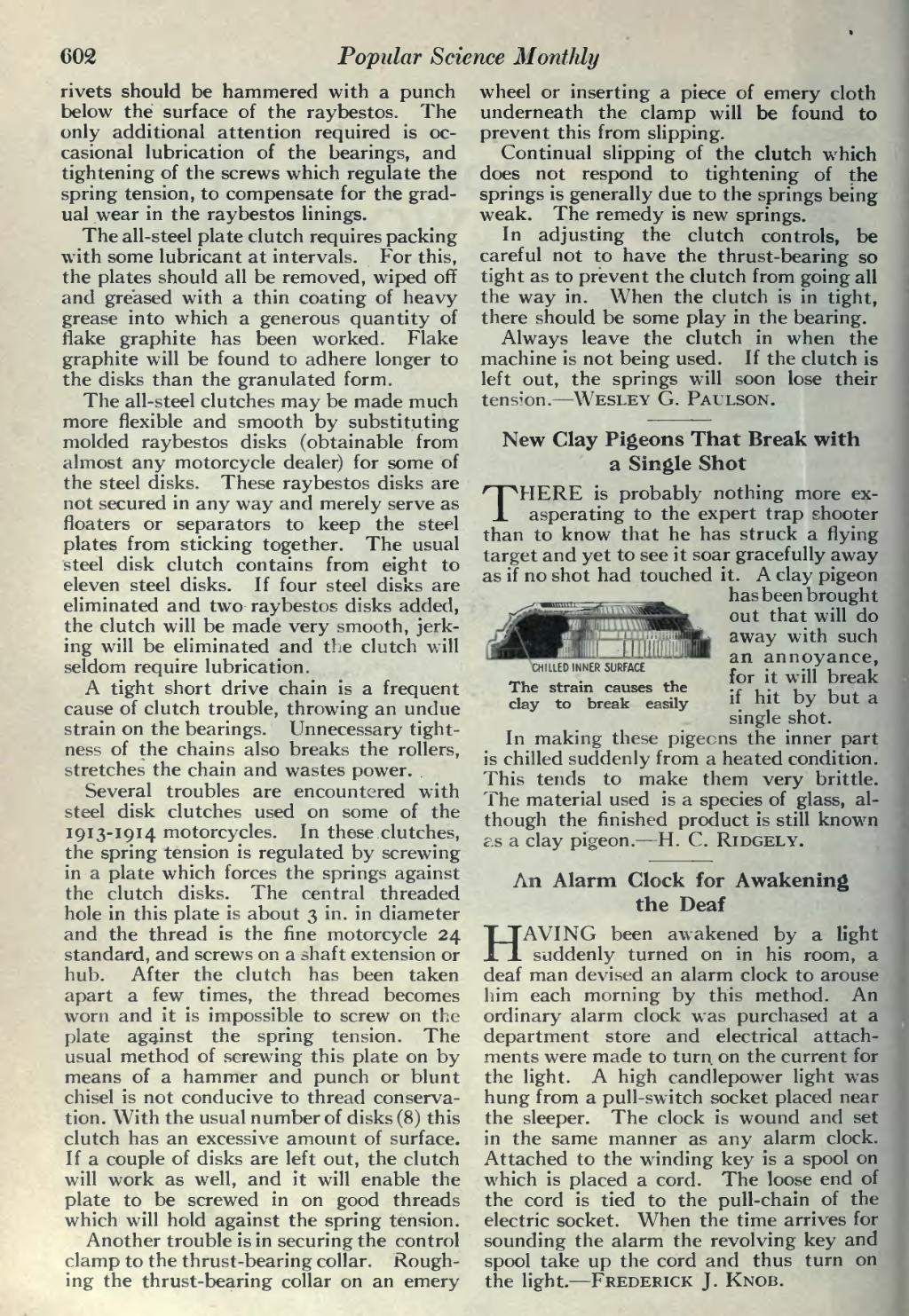602
��Popular Science Monthly
��rivets should be hammered with a punch below the surface of the raybestos. The only additional attention required is oc- casional lubrication of the bearings, and tightening of the screws which regulate the spring tension, to compensate for the grad- ual wear in the raybestos linings.
The all-steel plate clutch requires packing with some lubricant at intervals. For this, the plates should all be removed, wiped off and greased with a thin coating of heavy grease into which a generous quantity of flake graphite has been worked. Flake graphite will be found to adhere longer to the disks than the granulated form.
The all-steel clutches may be made much more flexible and smooth by substituting molded raybestos disks (obtainable from almost any motorcycle dealer) for some of the steel disks. These raybestos disks are not secured in any way and merely serve as floaters or separators to keep the steel plates from sticking together. The usual steel disk clutch contains from eight to eleven steel disks. If four steel disks are eliminated and two raybestos disks added, the clutch will be made very smooth, jerk- ing will be eliminated and the clutch will seldom require lubrication.
A tight short drive chain is a frequent cause of clutch trouble, throwing an undue strain on the bearings. Unnecessary tight- ness of the chains also breaks the rollers, stretches the chain and wastes power. ,
Several troubles are encountered with steel disk clutches used on some of the 1913-1914 motorcycles. In these clutches, the spring tension is regulated by screwing in a plate which forces the springs against the clutch disks. The central threaded hole in this plate is about 3 in. in diameter and the thread is the fine motorcycle 24 standard, and screws on a shaft extension or hub. After the clutch has been taken apart a few times, the thread becomes worn and it is impossible to screw on the plate against the spring tension. The usual method of screwing this plate on by means of a hammer and punch or blunt chisel is not conducive to thread conserva- tion. With the usual number of disks (8) this clutch has an excessive amount of surface. If a couple of disks are left out, the clutch will work as well, and it will enable the plate to be screwed in on good threads which will hold against the spring tension.
Another trouble is in securing the control clamp to the thrust-bearing collar. Rough- ing the thrust-bearing collar on an emery
��wheel or inserting a piece of emery cloth underneath the clamp will be found to prevent this from slipping.
Continual slipping of the clutch which does not respond to tightening of the springs is generally due to the springs being weak. The remedy is new springs.
In adjusting the clutch controls, be careful not to have the thrust-bearing so tight as to prevent the clutch from going all the way in. When the clutch is in tight, there should be some play in the bearing.
Always leave the clutch in when the machine is not being used. If the clutch is left out, the springs will soon lose their tension. — Wesley G. Paulson.
��New Clay Pigeons That Break with a Single Shot
THERE is probably nothing more ex- asperating to the expert trap shooter than to know that he has struck a flying target and yet to see it soar gracefully away as if no shot had touched it. A clay pigeon
has been brought out that will do away with such an annoyance, for it will break if hit by but a single shot. In making these pigeons the inner part is chilled suddenly from a heated condition. This tends to make them very brittle. The material used is a species of glass, al- though the finished product is still known as a clay pigeon. — H. C. Ridgely.
���CHILLED INNER SURFACE The strain causes the clay to break easily
��An Alarm Clock for Awakening the Deaf
HAVING been awakened by a light suddenly turned on in his room, a deaf man devised an alarm clock to arouse him each morning by this method. An ordinary alarm clock was purchased at a department store and electrical attach- ments were made to turn on the current for the light. A high candlepower light was hung from a pull-switch socket placed near the sleeper. The clock is wound and set in the same manner as any alarm clock. Attached to the winding key is a spool on which is placed a cord. The loose end of the cord is tied to the pull-chain of the electric socket. When the time arrives for sounding the alarm the revolving key and spool take up the cord and thus turn on the light.^ — Frederick J. Knob.
�� �
